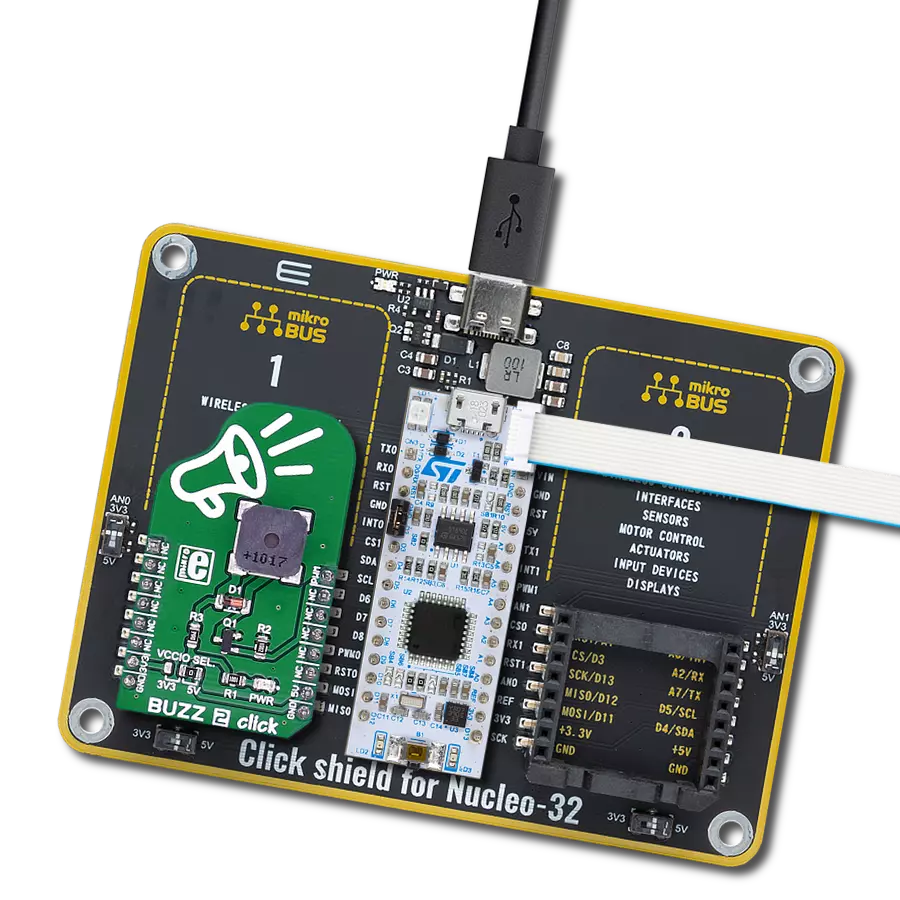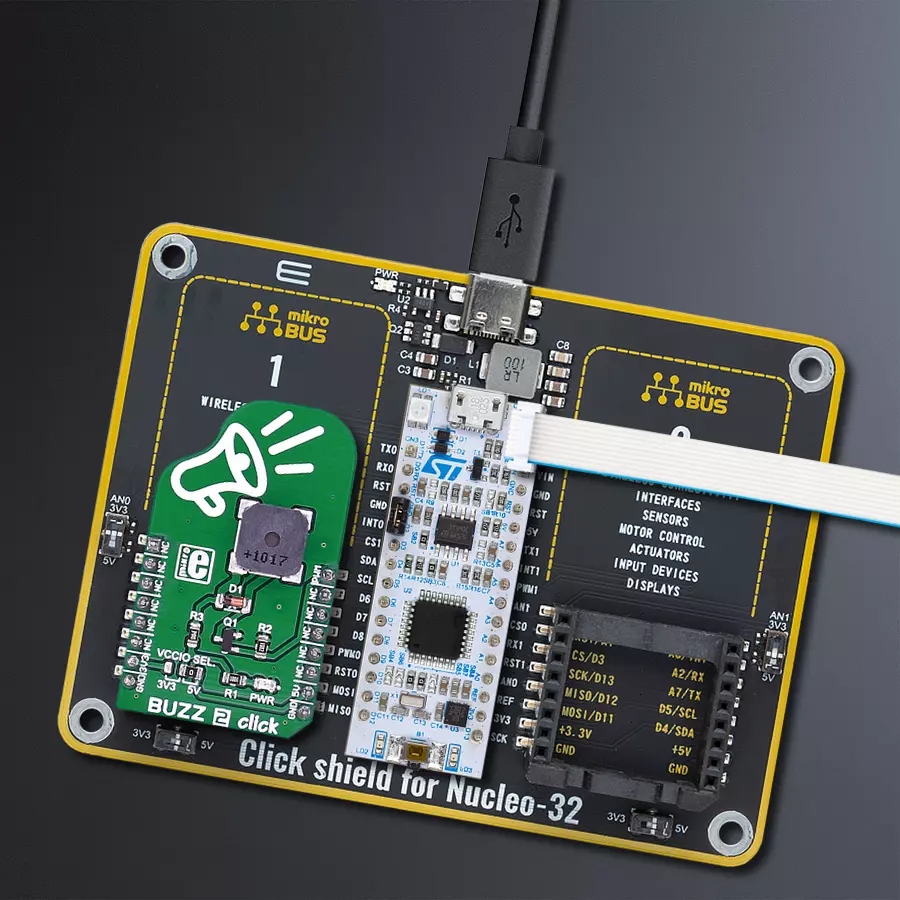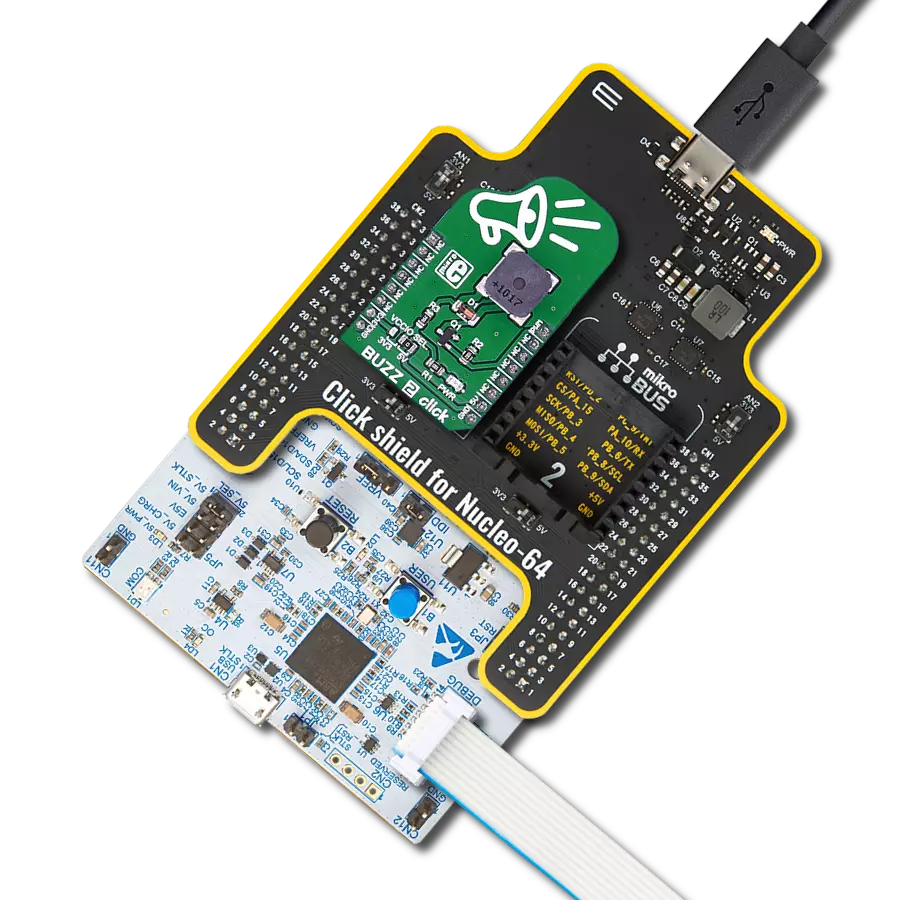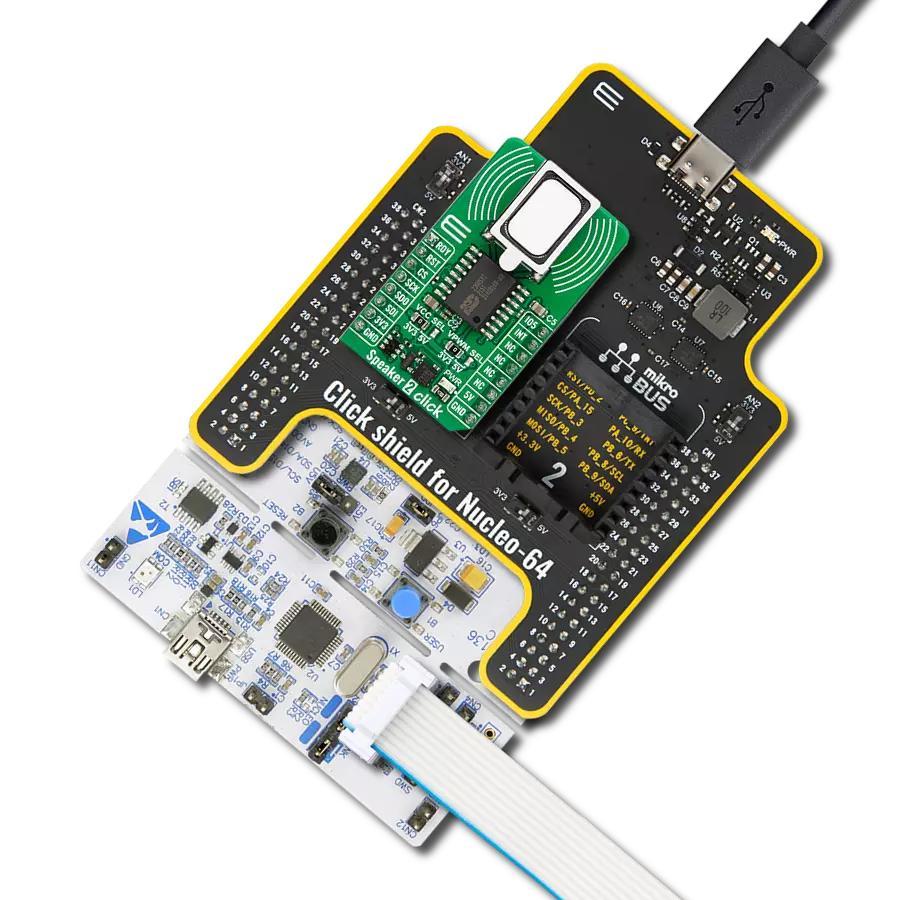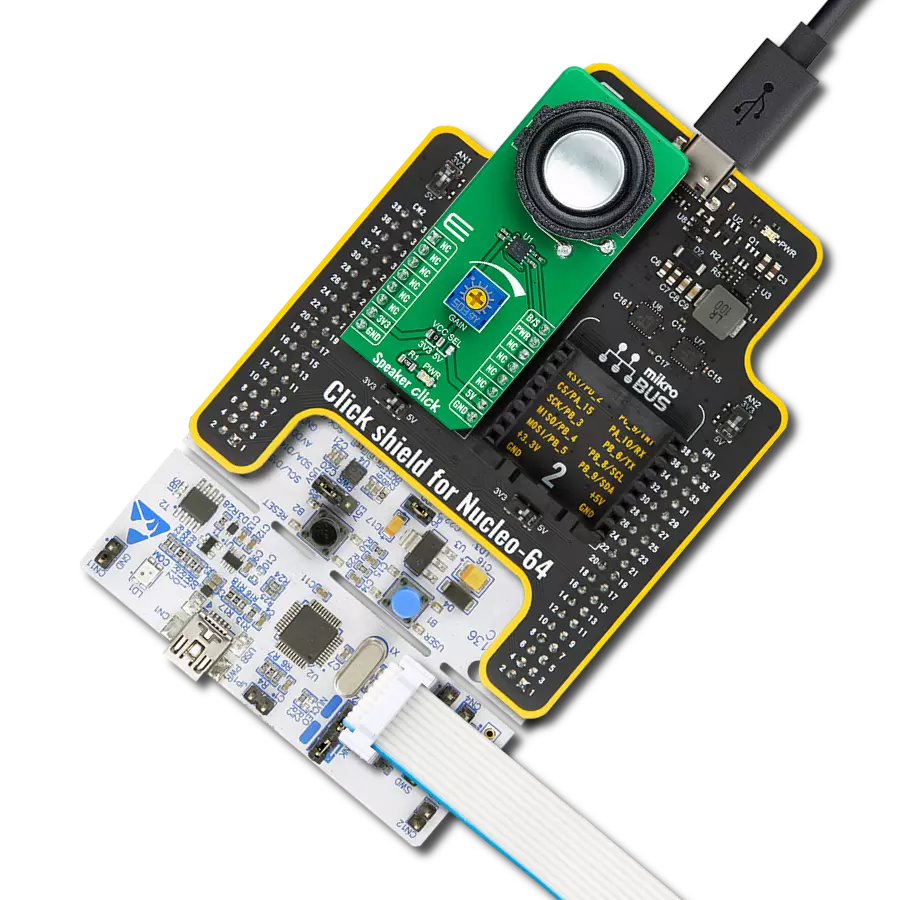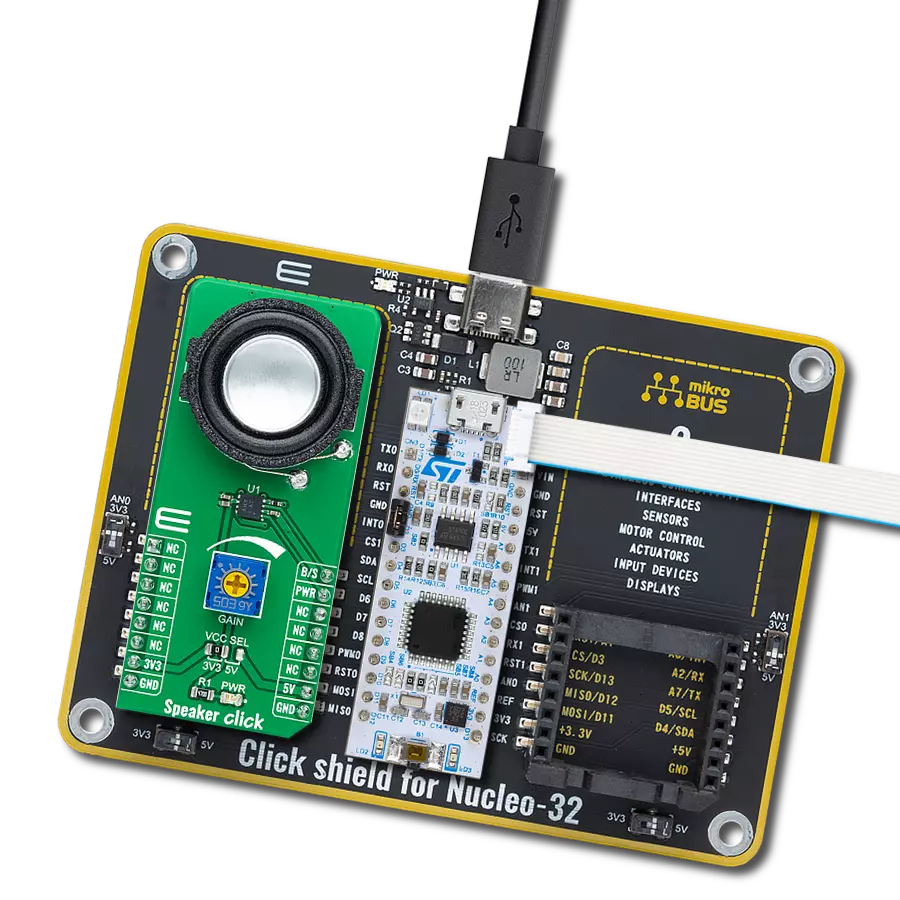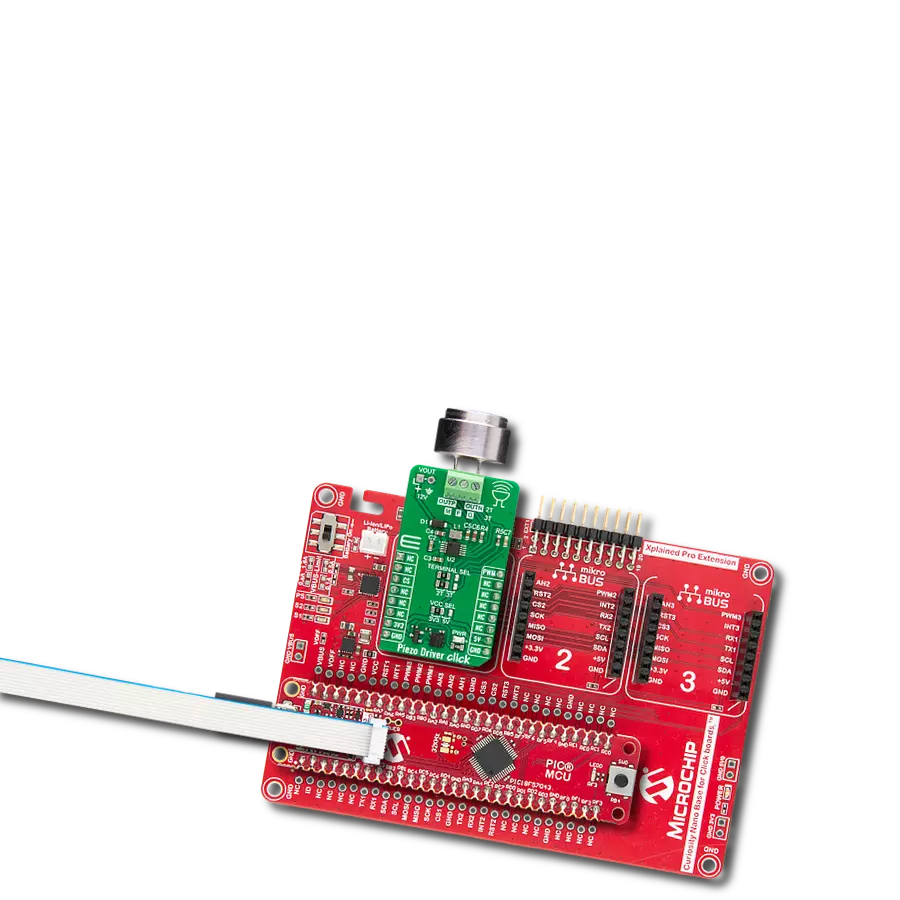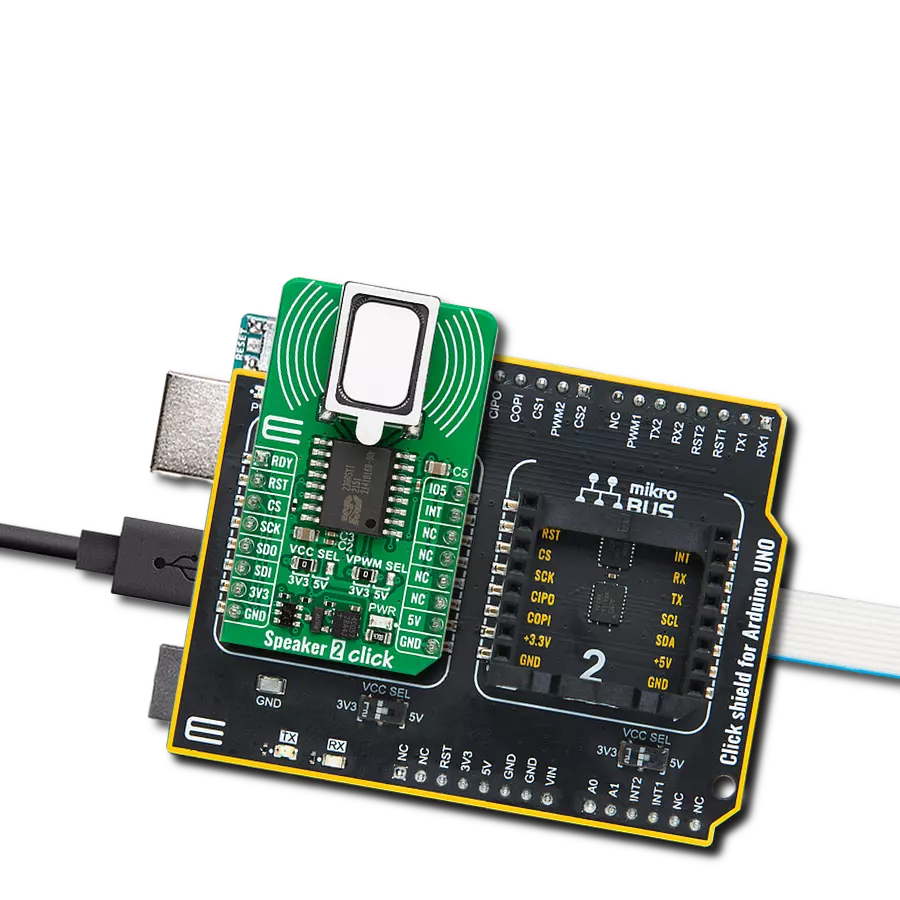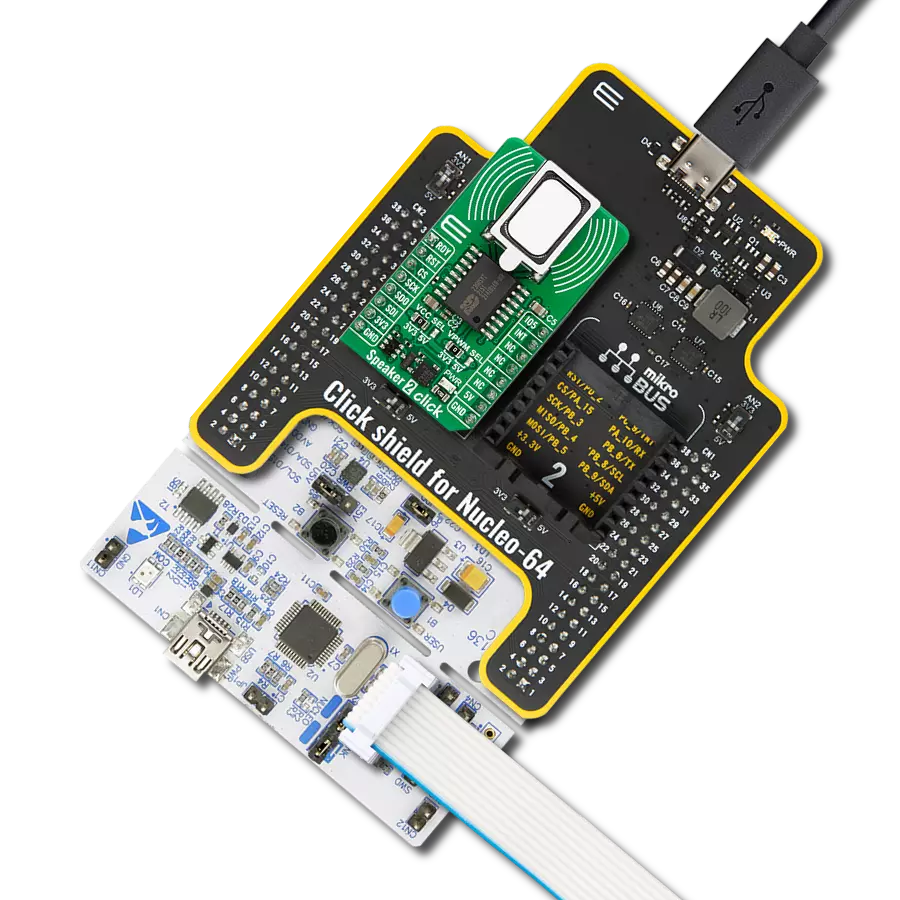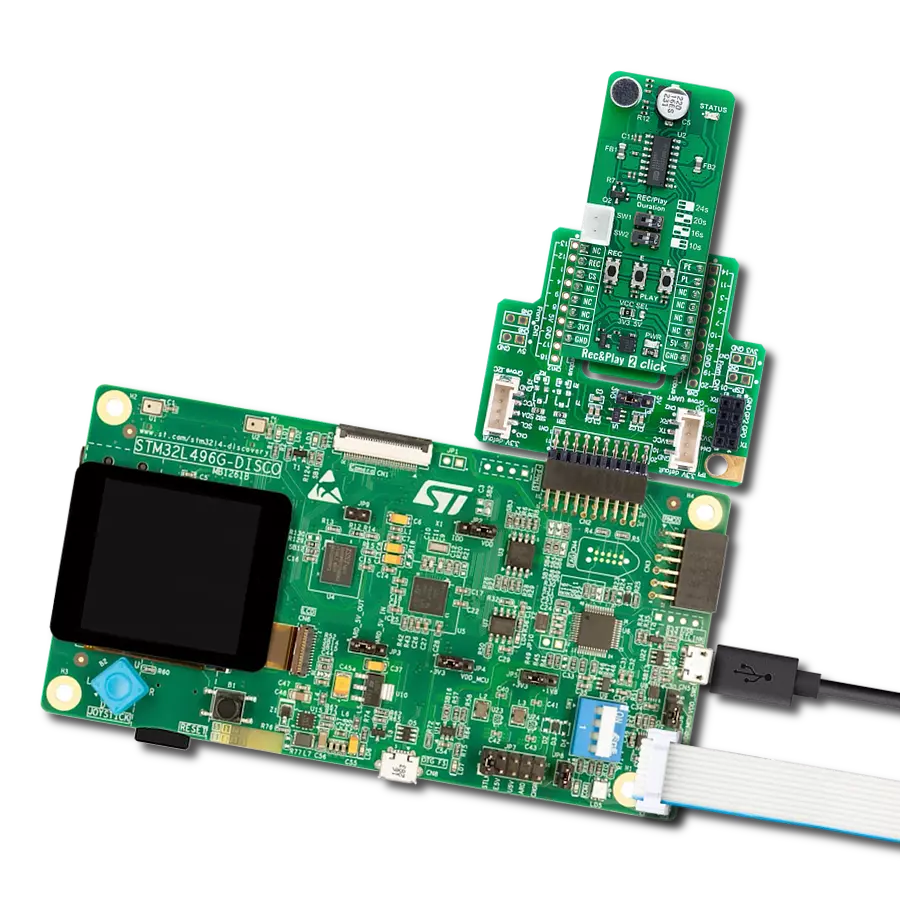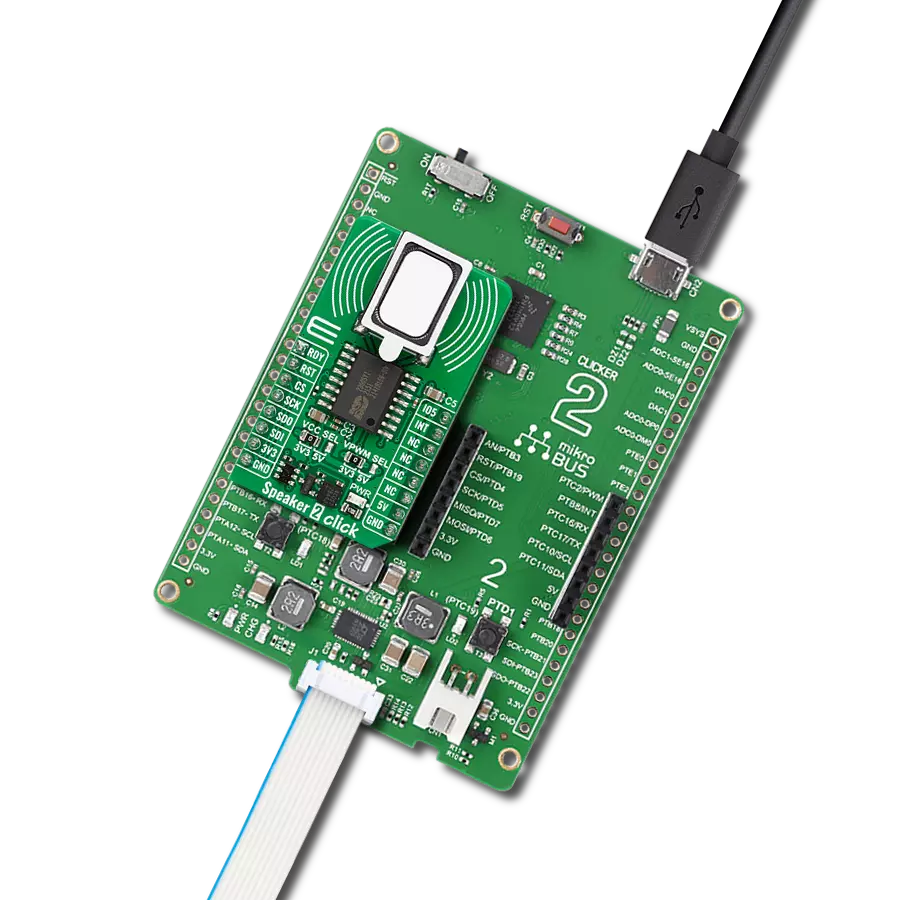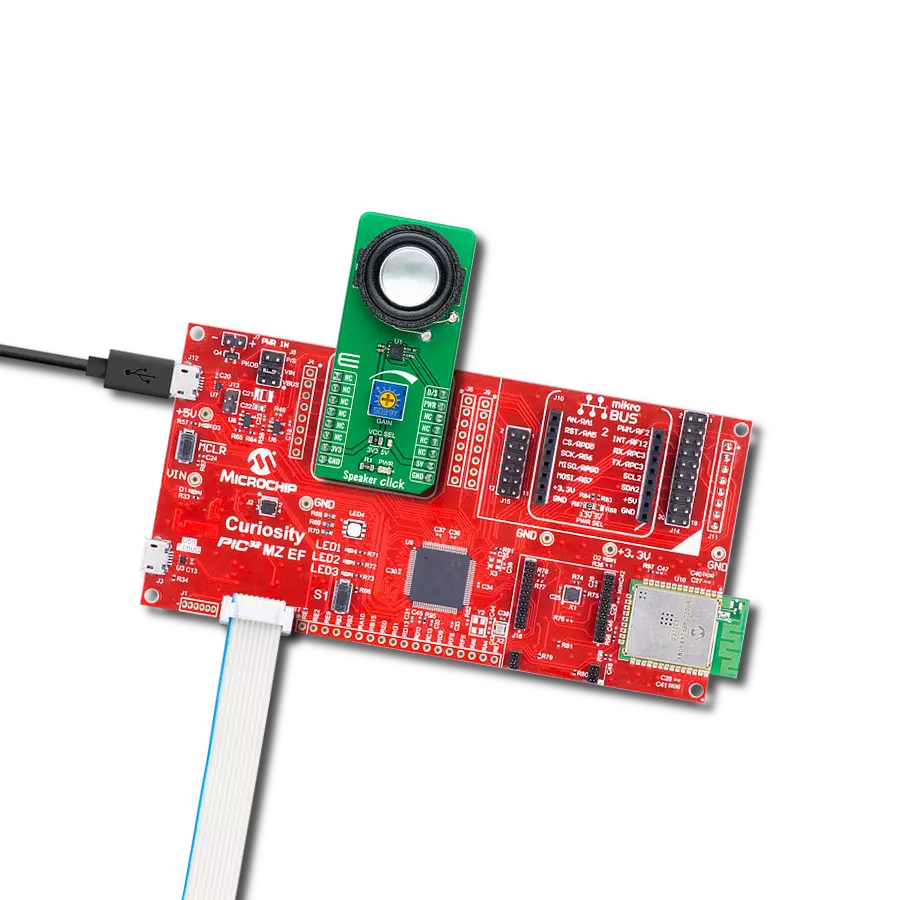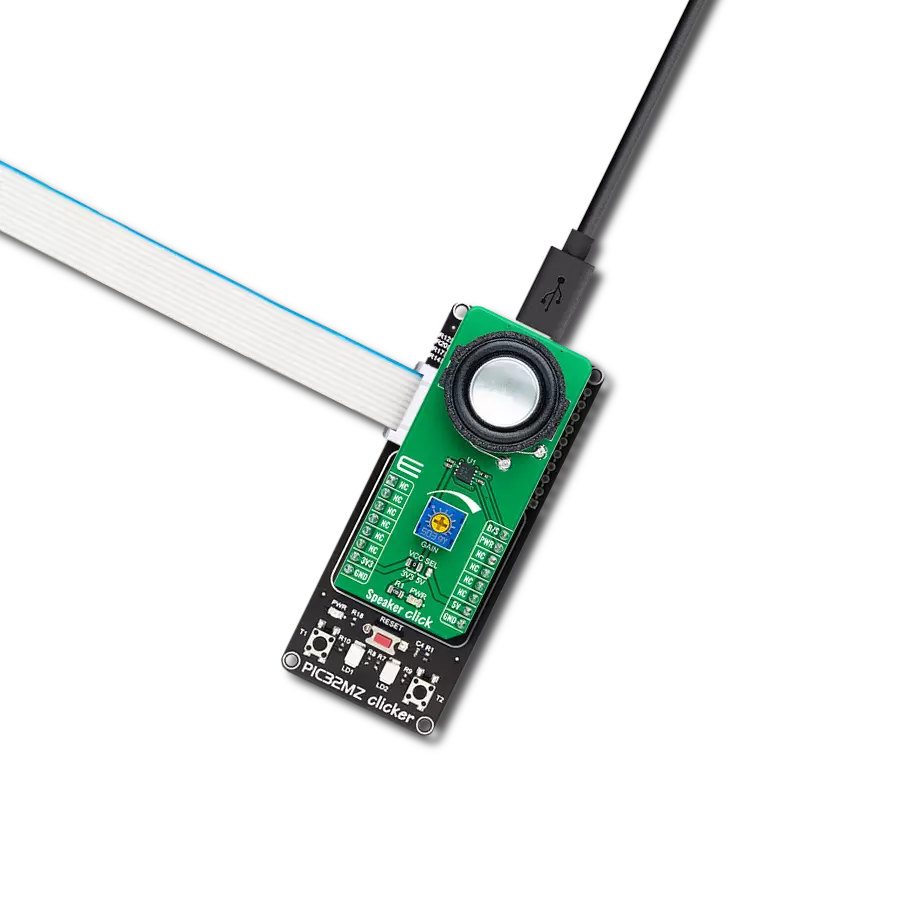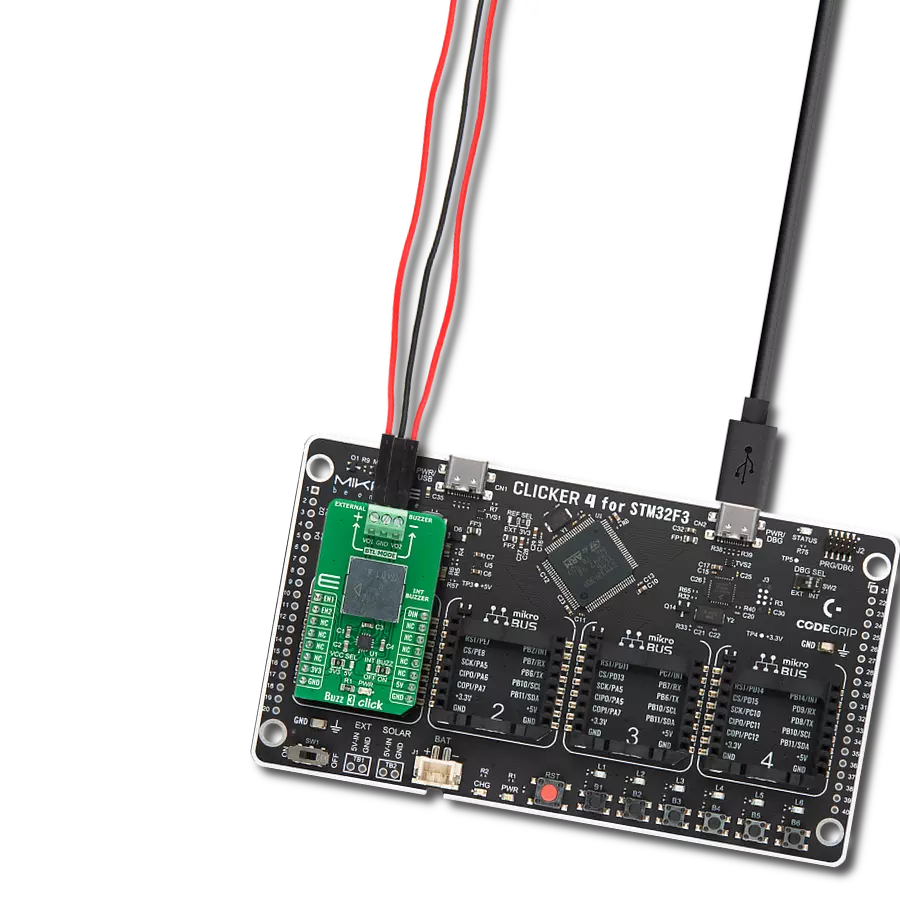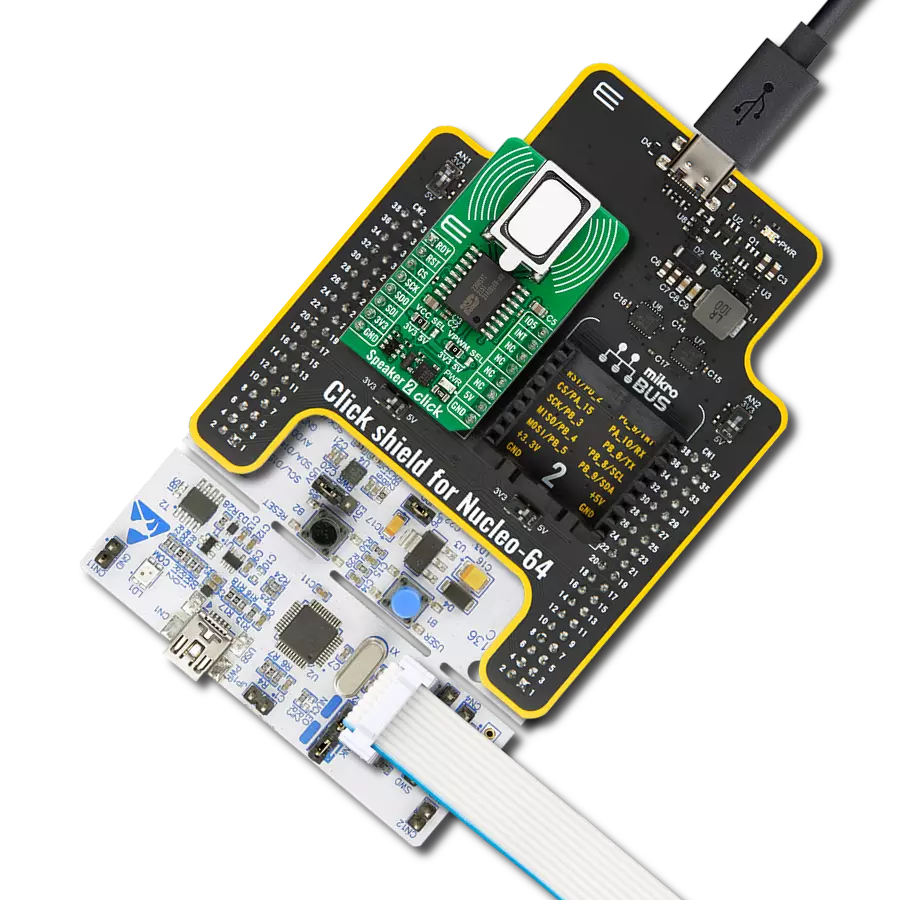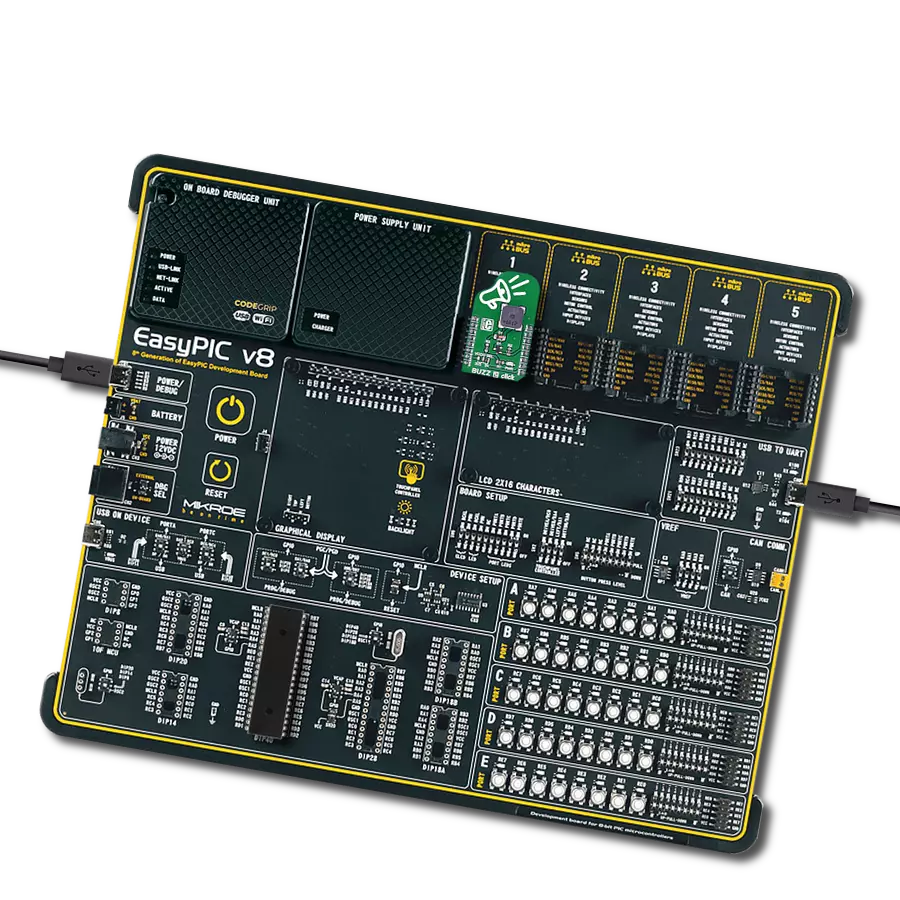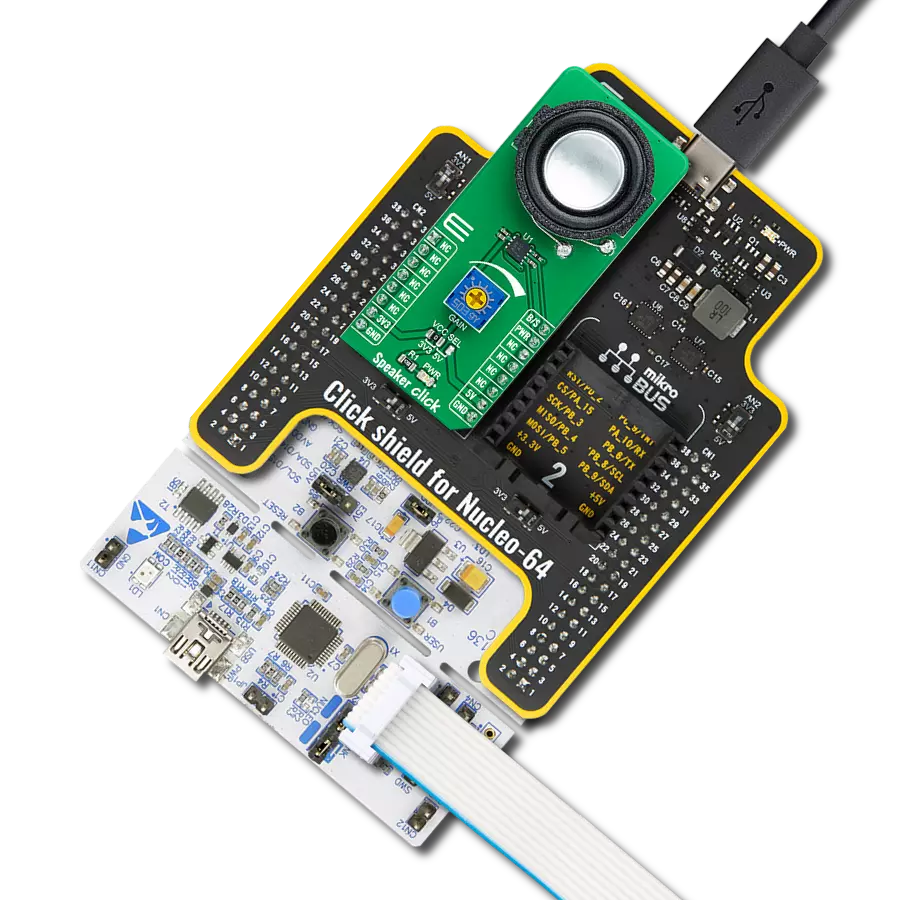Discover how our buzzer solution can revolutionize your daily life, from enhancing home security to streamlining industrial processes
A
A
Hardware Overview
How does it work?
BUZZ 2 Click is based on the CMT-8540S-SMT, a magnetic buzzer transducer from CUI Devices. The buzzer's resonant frequency is 4kHz. The click is designed to run on either a 3.3V or 5V power supply. The PWM pin on the mikroBUS™ line controls the CMT-8540S-SMT magnetic buzzer. You can create different sound patterns using
the Sound library supported in our compilers or utilize the microcontroller's internal PWM module to create the signal for the buzzer. Signal frequency determines the sound pitch, and the duty cycle determines the amplitude (sound volume). This Click board™ can operate with either 3.3V or 5V logic voltage levels selected via the
VCCIO SEL jumper. This way, both 3.3V and 5V capable MCUs can use the communication lines properly. Also, this Click board™ comes equipped with a library containing easy-to-use functions and an example code that can be used as a reference for further development.
Features overview
Development board
Nucleo 32 with STM32F031K6 MCU board provides an affordable and flexible platform for experimenting with STM32 microcontrollers in 32-pin packages. Featuring Arduino™ Nano connectivity, it allows easy expansion with specialized shields, while being mbed-enabled for seamless integration with online resources. The
board includes an on-board ST-LINK/V2-1 debugger/programmer, supporting USB reenumeration with three interfaces: Virtual Com port, mass storage, and debug port. It offers a flexible power supply through either USB VBUS or an external source. Additionally, it includes three LEDs (LD1 for USB communication, LD2 for power,
and LD3 as a user LED) and a reset push button. The STM32 Nucleo-32 board is supported by various Integrated Development Environments (IDEs) such as IAR™, Keil®, and GCC-based IDEs like AC6 SW4STM32, making it a versatile tool for developers.
Microcontroller Overview
MCU Card / MCU

Architecture
ARM Cortex-M0
MCU Memory (KB)
32
Silicon Vendor
STMicroelectronics
Pin count
32
RAM (Bytes)
4096
You complete me!
Accessories
Click Shield for Nucleo-32 is the perfect way to expand your development board's functionalities with STM32 Nucleo-32 pinout. The Click Shield for Nucleo-32 provides two mikroBUS™ sockets to add any functionality from our ever-growing range of Click boards™. We are fully stocked with everything, from sensors and WiFi transceivers to motor control and audio amplifiers. The Click Shield for Nucleo-32 is compatible with the STM32 Nucleo-32 board, providing an affordable and flexible way for users to try out new ideas and quickly create prototypes with any STM32 microcontrollers, choosing from the various combinations of performance, power consumption, and features. The STM32 Nucleo-32 boards do not require any separate probe as they integrate the ST-LINK/V2-1 debugger/programmer and come with the STM32 comprehensive software HAL library and various packaged software examples. This development platform provides users with an effortless and common way to combine the STM32 Nucleo-32 footprint compatible board with their favorite Click boards™ in their upcoming projects.
Used MCU Pins
mikroBUS™ mapper
Take a closer look
Click board™ Schematic

Step by step
Project assembly
Software Support
Library Description
This library contains API for BUZZ 2 Click driver.
Key functions:
buzz2_set_duty_cycle- BUZZ 2 sets PWM duty cyclebuzz2_play_sound- Play sound functionbuzz2_pwm_start- BUZZ 2 start PWM module
Open Source
Code example
The complete application code and a ready-to-use project are available through the NECTO Studio Package Manager for direct installation in the NECTO Studio. The application code can also be found on the MIKROE GitHub account.
/*!
* @file main.c
* @brief Buzz2 Click example
*
* # Description
* This example demonstrates the use of Buzz 2 Click boards.
*
* The demo application is composed of two sections :
*
* ## Application Init
* Initializes the driver and logger.
*
* ## Application Task
* Plays the Imperial March melody. Also logs an appropriate message on the USB UART.
*
* @note
* The minimal PWM Clock frequency required for this example is the frequency of tone C6 - 1047 Hz.
* So, in order to run this example and play all tones correctly, the user will need to decrease
* the MCU's main clock frequency in MCU Settings for the certain architectures
* in order to get the required PWM clock frequency.
*
* @author Jelena Milosavljevic
*
*/
#include "board.h"
#include "log.h"
#include "buzz2.h"
#define W 4*Q // Whole 4/4 - 4 Beats
#define H 2*Q // Half 2/4 - 2 Beats
#define Q 250 // Quarter 1/4 - 1 Beat
#define E Q/2 // Eighth 1/8 - 1/2 Beat
#define S Q/4 // Sixteenth 1/16 - 1/4 Beat
#define VOLUME 100 // goes up to 1000
static buzz2_t buzz2;
static log_t logger;
static void imperial_march( )
{
buzz2_play_sound(&buzz2, BUZZ2_NOTE_A6, VOLUME, Q );
Delay_ms ( 1 + Q );
buzz2_play_sound(&buzz2, BUZZ2_NOTE_A6, VOLUME, Q );
Delay_ms ( 1 + Q );
buzz2_play_sound(&buzz2, BUZZ2_NOTE_A6, VOLUME, Q );
Delay_ms ( 1 + Q );
buzz2_play_sound(&buzz2, BUZZ2_NOTE_F6, VOLUME, E + S );
Delay_ms ( 1 + E + S );
buzz2_play_sound(&buzz2, BUZZ2_NOTE_C7, VOLUME, S );
Delay_ms ( 1 + S );
buzz2_play_sound(&buzz2, BUZZ2_NOTE_A6, VOLUME, Q );
Delay_ms ( 1 + Q );
buzz2_play_sound(&buzz2, BUZZ2_NOTE_F6, VOLUME, E + S );
Delay_ms ( 1 + E + S );
buzz2_play_sound(&buzz2, BUZZ2_NOTE_C7, VOLUME, S );
Delay_ms ( 1 + S );
buzz2_play_sound(&buzz2, BUZZ2_NOTE_A6, VOLUME, H );
Delay_ms ( 1 + H );
buzz2_play_sound(&buzz2, BUZZ2_NOTE_E7, VOLUME, Q );
Delay_ms ( 1 + Q );
buzz2_play_sound(&buzz2, BUZZ2_NOTE_E7, VOLUME, Q );
Delay_ms ( 1 + Q );
buzz2_play_sound(&buzz2, BUZZ2_NOTE_E7, VOLUME, Q );
Delay_ms ( 1 + Q );
buzz2_play_sound(&buzz2, BUZZ2_NOTE_F7, VOLUME, E + S );
Delay_ms ( 1 + E + S );
buzz2_play_sound(&buzz2, BUZZ2_NOTE_C7, VOLUME, S );
Delay_ms ( 1 + S );
buzz2_play_sound(&buzz2, BUZZ2_NOTE_Ab6, VOLUME, Q );
Delay_ms ( 1 + Q );
buzz2_play_sound(&buzz2, BUZZ2_NOTE_F6, VOLUME, E + S );
Delay_ms ( 1 + E + S );
buzz2_play_sound(&buzz2, BUZZ2_NOTE_C7, VOLUME, S );
Delay_ms ( 1 + S );
buzz2_play_sound(&buzz2, BUZZ2_NOTE_A6, VOLUME, H );
Delay_ms ( 1 + H );
buzz2_play_sound(&buzz2, BUZZ2_NOTE_A7, VOLUME, Q );
Delay_ms ( 1 + Q );
buzz2_play_sound(&buzz2, BUZZ2_NOTE_A6, VOLUME, E + S );
Delay_ms ( 1 + E + S );
buzz2_play_sound(&buzz2, BUZZ2_NOTE_A6, VOLUME, S );
Delay_ms ( 1 + S );
buzz2_play_sound(&buzz2, BUZZ2_NOTE_A7, VOLUME, Q );
Delay_ms ( 1 + Q );
buzz2_play_sound(&buzz2, BUZZ2_NOTE_Ab7, VOLUME, E + S );
Delay_ms ( 1 + E + S );
buzz2_play_sound(&buzz2, BUZZ2_NOTE_G7, VOLUME, S );
Delay_ms ( 1 + S );
buzz2_play_sound(&buzz2, BUZZ2_NOTE_Gb7, VOLUME, S );
Delay_ms ( 1 + S );
buzz2_play_sound(&buzz2, BUZZ2_NOTE_E7, VOLUME, Q );
Delay_ms ( 1 + Q );
buzz2_play_sound(&buzz2, BUZZ2_NOTE_F7, VOLUME, E );
Delay_ms ( 1 + E );
Delay_ms ( 1 + E );
buzz2_play_sound(&buzz2, BUZZ2_NOTE_Bb6, VOLUME, E );
Delay_ms ( 1 + E );
buzz2_play_sound(&buzz2, BUZZ2_NOTE_Eb7, VOLUME, Q );
Delay_ms ( 1 + Q );
buzz2_play_sound(&buzz2, BUZZ2_NOTE_D7, VOLUME, E + S );
Delay_ms ( 1 + E + S );
buzz2_play_sound(&buzz2, BUZZ2_NOTE_Db7, VOLUME, S );
Delay_ms ( 1 + S );
buzz2_play_sound(&buzz2, BUZZ2_NOTE_C7, VOLUME, S );
Delay_ms ( 1 + S );
buzz2_play_sound(&buzz2, BUZZ2_NOTE_B6, VOLUME, S );
Delay_ms ( 1 + S );
buzz2_play_sound(&buzz2, BUZZ2_NOTE_C7, VOLUME, E );
Delay_ms ( 1 + E );
Delay_ms ( 1 + E );
buzz2_play_sound(&buzz2, BUZZ2_NOTE_F6, VOLUME, E );
Delay_ms ( 1 + E );
buzz2_play_sound(&buzz2, BUZZ2_NOTE_Ab6, VOLUME, Q );
Delay_ms ( 1 + Q );
buzz2_play_sound(&buzz2, BUZZ2_NOTE_F6, VOLUME, E + S );
Delay_ms ( 1 + E + S );
buzz2_play_sound(&buzz2, BUZZ2_NOTE_A6, VOLUME, S );
Delay_ms ( 1 + S );
buzz2_play_sound(&buzz2, BUZZ2_NOTE_C7, VOLUME, Q );
Delay_ms ( 1 + Q );
buzz2_play_sound(&buzz2, BUZZ2_NOTE_A6, VOLUME, E + S );
Delay_ms ( 1 + E + S );
buzz2_play_sound(&buzz2, BUZZ2_NOTE_C7, VOLUME, S );
Delay_ms ( 1 + S );
buzz2_play_sound(&buzz2, BUZZ2_NOTE_E7, VOLUME, H );
Delay_ms ( 1 + H );
buzz2_play_sound(&buzz2, BUZZ2_NOTE_A7, VOLUME, Q );
Delay_ms ( 1 + Q );
buzz2_play_sound(&buzz2, BUZZ2_NOTE_A6, VOLUME, E + S );
Delay_ms ( 1 + E + S );
buzz2_play_sound(&buzz2, BUZZ2_NOTE_A6, VOLUME, S );
Delay_ms ( 1 + S );
buzz2_play_sound(&buzz2, BUZZ2_NOTE_A7, VOLUME, Q );
Delay_ms ( 1 + Q );
buzz2_play_sound(&buzz2, BUZZ2_NOTE_Ab7, VOLUME, E + S );
Delay_ms ( 1 + E + S );
buzz2_play_sound(&buzz2, BUZZ2_NOTE_G7, VOLUME, S );
Delay_ms ( 1 + S );
buzz2_play_sound(&buzz2, BUZZ2_NOTE_Gb7, VOLUME, S );
Delay_ms ( 1 + S );
buzz2_play_sound(&buzz2, BUZZ2_NOTE_E7, VOLUME, S );
Delay_ms ( 1 + S );
buzz2_play_sound(&buzz2, BUZZ2_NOTE_F7, VOLUME, E );
Delay_ms ( 1 + E );
Delay_ms ( 1 + E );
buzz2_play_sound(&buzz2, BUZZ2_NOTE_Bb6, VOLUME, E );
Delay_ms ( 1 + E );
buzz2_play_sound(&buzz2, BUZZ2_NOTE_Eb7, VOLUME, Q );
Delay_ms ( 1 + Q );
buzz2_play_sound(&buzz2, BUZZ2_NOTE_D7, VOLUME, E + S );
Delay_ms ( 1 + E + S );
buzz2_play_sound(&buzz2, BUZZ2_NOTE_Db7, VOLUME, S );
Delay_ms ( 1 + S );
buzz2_play_sound(&buzz2, BUZZ2_NOTE_C7, VOLUME, S );
Delay_ms ( 1 + S );
buzz2_play_sound(&buzz2, BUZZ2_NOTE_B6, VOLUME, S );
Delay_ms ( 1 + S );
buzz2_play_sound(&buzz2, BUZZ2_NOTE_C7, VOLUME, E );
Delay_ms ( 1 + E );
Delay_ms ( 1 + E );
buzz2_play_sound(&buzz2, BUZZ2_NOTE_F6, VOLUME, E );
Delay_ms ( 1 + E );
buzz2_play_sound(&buzz2, BUZZ2_NOTE_Ab6, VOLUME, Q );
Delay_ms ( 1 + Q );
buzz2_play_sound(&buzz2, BUZZ2_NOTE_F6, VOLUME, E + S );
Delay_ms ( 1 + E + S );
buzz2_play_sound(&buzz2, BUZZ2_NOTE_C7, VOLUME, S );
Delay_ms ( 1 + S );
buzz2_play_sound(&buzz2, BUZZ2_NOTE_A6, VOLUME, Q );
Delay_ms ( 1 + Q );
buzz2_play_sound(&buzz2, BUZZ2_NOTE_F6, VOLUME, E + S );
Delay_ms ( 1 + E + S );
buzz2_play_sound(&buzz2, BUZZ2_NOTE_C7, VOLUME, S );
Delay_ms ( 1 + S );
buzz2_play_sound(&buzz2, BUZZ2_NOTE_Ab6, VOLUME, H );
Delay_ms ( 1 + H );
}
void application_init ( void ) {
log_cfg_t log_cfg; /**< Logger config object. */
buzz2_cfg_t buzz2_cfg; /**< Click config object. */
/**
* Logger initialization.
* Default baud rate: 115200
* Default log level: LOG_LEVEL_DEBUG
* @note If USB_UART_RX and USB_UART_TX
* are defined as HAL_PIN_NC, you will
* need to define them manually for log to work.
* See @b LOG_MAP_USB_UART macro definition for detailed explanation.
*/
LOG_MAP_USB_UART( log_cfg );
log_init( &logger, &log_cfg );
log_info( &logger, " Application Init " );
// Click initialization.
buzz2_cfg_setup( &buzz2_cfg );
BUZZ2_MAP_MIKROBUS( buzz2_cfg, MIKROBUS_1 );
err_t init_flag = buzz2_init( &buzz2, &buzz2_cfg );
if ( init_flag == PWM_ERROR ) {
log_error( &logger, " Application Init Error. " );
log_info( &logger, " Please, run program again... " );
for ( ; ; );
}
buzz2_set_duty_cycle ( &buzz2, 0.0 );
buzz2_pwm_start( &buzz2 );
Delay_ms ( 100 );
log_info( &logger, " Application Task " );
}
void application_task ( void )
{
log_printf( &logger, "Playing the Imperial March melody ...\r\n" );
imperial_march( );
// 10 seconds delay
Delay_ms ( 1000 );
Delay_ms ( 1000 );
Delay_ms ( 1000 );
Delay_ms ( 1000 );
Delay_ms ( 1000 );
Delay_ms ( 1000 );
Delay_ms ( 1000 );
Delay_ms ( 1000 );
Delay_ms ( 1000 );
Delay_ms ( 1000 );
}
int main ( void )
{
/* Do not remove this line or clock might not be set correctly. */
#ifdef PREINIT_SUPPORTED
preinit();
#endif
application_init( );
for ( ; ; )
{
application_task( );
}
return 0;
}
// ------------------------------------------------------------------------ END
Additional Support
Resources
Category:Speakers
